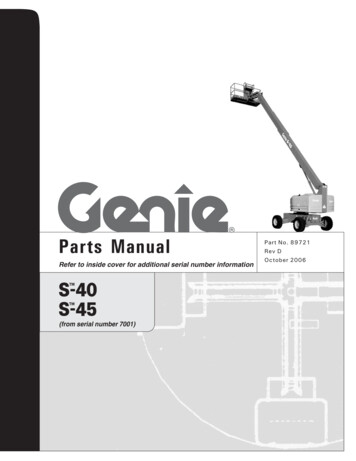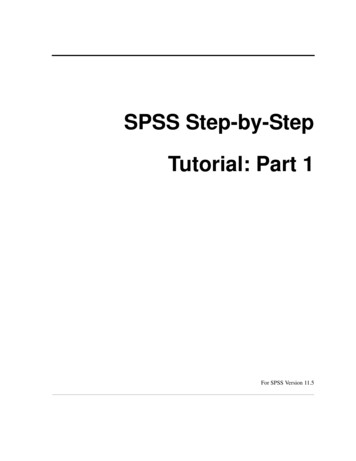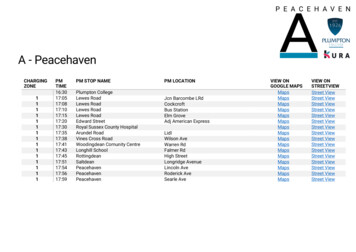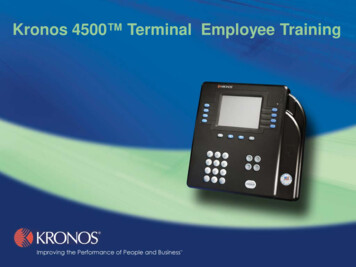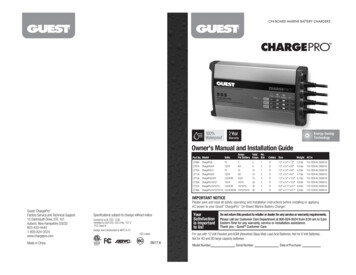
Transcription
ON-BOARD MARINE BATTERY CHARGERSCHARGEPROTM2 Year100%WaterproofBCWarrantyEnergy SavingTechnologyOwner's Manual and Installation GuidePart No. ModelVoltsAmpsTotal No.Per Battery Amps BatCables SizeWeight AC /510/1010/10/1010/10/10/106'6'6'6'6'6'6'6'3.2 lbs4.5 lbs4.2 lbs4.7 lbs6.7 lbs6.6 lbs8.0 lbs8.5 ro10/10/10/1058101015203040121232347.5" x 2.4" x 7.2"7.5" x 2.4" x 9.0"7.5" x 2.4" x 9.0"7.5" x 2.4" x 9.0"7.5" x 2.4" x 12.9"7.5" x 2.4" x 12.9"9.0" x 4.11" x 8.7"9.0" x 4.11" x 8.7"110-120V AC 50/60 Hz110-120V AC 50/60 Hz110-120V AC 50/60 Hz110-120V AC 50/60 Hz110-120V AC 50/60 Hz110-120V AC 50/60 Hz110-120V AC 50/60 Hz110-120V AC 50/60 HzIMPORTANT NOTICEPlease save and read all safety, operating and installation instructions before installing or applyingAC power to your Guest ChargePro On-Board Marine Battery Charger.Guest ChargePro Factory Service and Technical Support15 Dartmouth Drive, STE 101Auburn, New Hampshire 03032603-433-44401-800-824-0524www.chargepro.com Made in ChinaSpecifications subject to change without noticeConforms to UL STD. 1236Certified to CSA STD. C22.2 No. 107.2FCC Class BDesign and Constructed to ABYC A-31BCDo not return this product to retailer or dealer for any service or warranty requirements.Please call our Customer Care Department at 800-824-0524 from 8:30 am to 5pmEastern Time for any warranty, service or installation assistance.Thank you - Guest Customer CareFor use with 12 Volt Flooded and AGM (Absorbed Glass Mat) Lead Acid Batteries. Not for 6 Volt Batteries.Not for 4D and 8D large capacity batteries.CEC Listed5009218YourSatisfactionis Importantto Us!09/17 AModel Number:Serial Number:Date of Purchase:
TABLE OF CONTENTSIntroduction.Important Safety Instructions.page 1pages 2-7General Overview.page 8General Operation.pages 9-10Installation.pages 11-13Typical Wiring.pages 14-23Charging Your Batteries.page 24Maintenance.page 25Trouble Shooting.page 26Warranty Information.page 27IMPORTANT NOTICE: FCC CLASS B PART 15 NOTIFICATIONChargePro On-Board Marine Chargers have been designed and tested to comply with FCC Class B part15. If in a residential setting, you are encountering interference with TV and radio reception, simply removeAC power from the ChargePro On-Board Marine Battery Charger to confirm if it is causing interference.End users can then explore the following to minimize interference:1) Choose a different AC circuit to power your ChargePro On-Board Marine Battery Charger2) Make sure your outlet is properly grounded.3) Re-position receiving antenna.4) Purchase a separate AC line filter.5) Relocate the ChargePro On-Board Marine Battery Charger so that it is at the furthest pointfrom home receiving equipment,TV, radio, etc.
INTRODUCTIONSAFETY INSTRUCTIONS12ChargePro On-Board Marine Battery ChargersThank you for purchasing our newest generation Guest On-Board Marine Battery Chargerswith leading advancements in digital charging technology and waterproof design/construction.Our all digital charging platform incorporates the latest in embedded microprocessor andsoftware control for precision 5-Stage Performance Charging of all 12 volt Flooded and AGMlead acid batteries. Designed to maximize individual battery performance and extend battery life. ChargePro automatically analyzes battery connections, initiates a precharge pulse (for batteries 10 VDC), fully charges and conditions each battery individually. When charging is completedeach output will enter into an auto maintain (Energy Saver) mode safe for long and short termstorage. ChargePro will only turn on as needed to maintain fully charged batteries, loweringAC consumption and reducing operating cost.Additional Features Include: All digital charging technology Fully automatic 5-stage performance charging Dedicated battery charging, sensing and control per bank Expanded LED charge status monitor Wiring and battery fault detection Auto-maintain energy saver mode 100% waterproof and shock resistant for all fresh and saltwater applications Pre-wired for easy installation For all 12 volt Flooded and AGM lead acid batteries Built-in safety: reverse polarity, over-current, over-voltage, over-temperature and ignition protection.In-line DC safety fuses for maximum DC wire protection 2 year warrantyImportant Safety InstructionsSAVE THESE INSTRUCTIONSThis manual contains important safety and operating instructions for the ChargePro On-Board Marine Battery Charger Series.CAUTION - To reduce the risk of injury, charge only 12V Flooded and AGM leadacid batteries. Other types of batteries may burst, causing personal injury.EXTERNAL CONNECTIONS TO CHARGER SHALL COMPLY WITH THE UNITED STATESCOAST GUARD ELECTRICAL REGULATIONS (33CFR183, SUB PART 1).Before connecting your batteries or applying AC power, read all instructions and cautionarymarkings on the battery charger, cables, and batteries.WARNINGTo reduce the risk of injury to user or property; the user must read and understand the instructionmanual and all warnings on the charger and batteries before use.WARNING1. WARNING - RISK OF EXPLOSIVE GASES.a. WORKING IN THE VICINITY OF A LEAD-ACID BATTERY IS DANGEROUS. BATTERIESGENERATE EXPLOSIVE GASES DURING NORMAL BATTERY OPERATION. FOR THISREASON, IT IS OF UTMOST IMPORTANCE THAT YOU FOLLOW THE INSTRUCTIONSEACH TIME YOU USE THE CHARGER.b. To reduce risk of battery explosion, follow these instructions and those marked on the battery.2. Use charger for charging a LEAD-ACID battery only. It is not intended to supply power to anextra-low-voltage electrical system or to charge dry-cell batteries. Charging dry-cell batteriesmay burst and cause injury to persons and property.3. Use of an attachment not recommended or sold by Guest may result in a risk of fire,electric shock, or injury to persons.4. To reduce risk of damage to electric plug and cord, pull by plug rather than cord whendisconnecting charger.
SAFETY INSTRUCTIONSSAFETY INSTRUCTIONS34Important Safety InstructionsImportant Safety Instructions5. Extension cords:11. GROUNDING AND AC POWER CORD CONNECTION INSTRUCTIONSa. Charger should be grounded to reduce risk of electric shock. Charger is equipped withan electric cord having in equipment-grounding conductor and a grounding plug. The plugmust be plugged into a 120 VAC GFCI protected (Ground Fault Circuit Interrupt) outletthat is properly installed and grounded in accordance with all local codes and ordinances.a. Pins on the plug of the extension cord are the same number, size and shape as thoseon the plug of the charger.b. Use only a properly wired extension cord in good electrical condition.c. Use an industrial grade / heavy duty UL or CSA approved and grounded extension cord.Check extension cord before use for damage, bent prongs, and cuts. Replace if damaged.Always make your extension cord connection on the charger side first. After connectingthe extension cord to the charger proceed to plug the extension cord into anearby 120 VAC GFCI protected (Ground Fault Circuit Interrupt) outlet.Below are manufacturer recommendations for the right size UL or CSA Approved groundedextension cord.ChargePro 5, 4/4, 5/5, 10 and 5/5/5:i. Up to 50 feet in length use a 3 conductor 18 AWG extension cord.ii. 50 to 100 feet in length use a 3 conductor 16 AWG extension cord.iii. 100 to 150 feet in length use a 3 conductor 14 AWG extension cord.ChargePro 10/10, 10/10/10 and 10/10/10/10:i. Up to 50 feet in length use a 3 conductor 14 AWG extension cord.ii. 50 to 100 feet in length use a 3 conductor 12 AWG extension cord.DANGERNever alter AC cord or plug provided - If it will not fit outlet, have proper outlet installed by a qualifiedelectrician. Improper connection can result in a risk of an electric shock.b. This battery charger is for use on a nominal 120-volt circuit, and has a grounding plugthat looks like the plug illustrated in figure A. A temporary adapter, which looks like theadapter illustrated in figure B may be used to connect this plug to a two-pole receptacleas shown in figure B if a properly grounded outlet is not available. The temporaryadapter should be used only until a properly grounded GFCI protected outletcan be installed by a qualified electrician.DANGERBefore using adapter as illustrated, be certain that center screw of outlet plate is grounded.The green-colored rigid ear or leg extending from adapter must be connected to a properlygrounded outlet - make certain it is grounded. If necessary, replace original outlet cover platescrew with a longer screw that will secure adapter ear or lug to outlet cover plate and makeground connection to grounded GFCI protected outlet.iii. 100 to 150 feet in length use a 3 conductor 10 AWG extension cord.Figure A6. Do not operate charger if any protective AC and DC cable insulation, DC fuse holders or ringterminals have been damaged or compromised. Contact Guest immediately to returnthe charger for service and repair.Adapter7. Do not operate the charger if it has received a sharp blow, direct hit of force, been droppedor otherwise damaged in any way. Contact Guest immediately to return the chargerfor service and repair.8. Do not disassemble charger. Incorrect reassembly may result in a risk of electric shock orfire. If service or repair is required please call Guest customer service at 800-824-0524between 8:30am-5pm (EST) Monday through Friday, or via www.chargepro.com. Unauthorizedattempts to service, repair or modify may result in a risk of electrical shock, fire or explosionand will void warranty.9. To reduce risk of electric shock, unplug charger from outlet before attempting any maintenanceor cleaning.10.Do not expose AC power cord connection to rain or snow.Figure BGrounding pinGrounding meansMetal screw120 VAC GFCI protected (Ground Fault Circuit Interrupt)outlet via house panel breaker or GFCI outlet (not shown)Use of an adapter is not allowed in Canada. If a grounding type receptacle is not available,do not use this appliance until the proper GFCI protected outlet is installed by a qualified electrician.
SAFETY INSTRUCTIONSSAFETY INSTRUCTIONS56Important Safety InstructionsImportant Safety Instructions12. PERSONAL PRECAUTIONS13. PREPARING TO CHARGE A BATTERYCAUTIONa. Consider having someone close enough or within the range of your voice to come to youraid when you work near a lead-acid battery.b. Have plenty of soap, water and baking soda nearby in case battery acid comes in contactwith skin, clothes or eyes.c. Wear complete eye protection, hand and clothing protection. Avoid touching eyes while workingnear a battery.d. If battery acid contacts skin or clothing, wash immediately with soap and water. If acid enterseye, immediately flood eye with running cold water for at least 15 minutes and get medicalattention immediately.If electrolyte is taken internally, drink large quantities of water or milk. DO NOT inducevomiting. Get prompt medical attention.e. NEVER smoke, strike a match or cause a spark or flame in vicinity of battery or engine.f. Be extra cautious to reduce risk of dropping a metal tool onto the battery. It might spark orshort-circuit a battery or other electrical hardware which may cause an explosion or fire.g. Remove all personal metal items such as rings, bracelets, necklaces, watches, and jewelrywhen working near a battery. A battery can produce a short circuit current high enough toweld a ring or any other metal, causing serious burns.h. Use charger for charging a LEAD-ACID battery only. It is not intended to supply powerto a low voltage electrical system other than in a start-motor application. Do not usebattery charger for charging dry-cell batteries that are commonly used with homeappliances. These batteries may burst and cause injury to persons and damage to property.i. NEVER charge a frozen, damaged or leaking battery.j. Keep other persons, children and pets away from batteries and your charger during operationto avoid serious injury, death, fire or explosion.DANGER: RISK OF ELECTRIC SHOCK.Do not touch uninsulated portion of output connector or uninsulated battery terminalif 3 or more batteries are connected in series.CAUTIONa. If necessary to remove a battery from a boat to charge, always remove the groundednegative terminal from the battery first. Make sure all accessories in the boat areoff, as to not cause an arc.b. Be sure the area around the charger and batteries is well ventilated while the battery is being charged.c. Neutralize with baking soda any electrolyte that spills on a vehicle or in the work area.After neutralizing, rinse contaminated area clean with water.d. Clean battery terminals. Be careful to keep corrosion from coming in contact with eyes.e. For flooded batteries with removable caps, ONLY ADD DISTILLED WATER in each celluntil electrolyte reaches levels specified by the battery manufacturer. Do not over fill.For a maintenance free battery without removable caps, such as valve regulated leadacid batteries, carefully follow manufacturer’s recharging instructions.f. Study all battery manufacturers’ specific precautions; warnings and instructions while chargingand recommended rates of charge. Never charge a battery with missing safety vent caps.g. Do not overcharge batteries trying to charge non 12 Volt flooded or AGM lead acid batteries.
SAFETY INSTRUCTIONSGENERAL OVERVIEW87Charger Location & DC ConnectionGeneral Overview14. CHARGER LOCATIONThe new Guest ChargePro On-Board Marine Battery Charger series has been fully redesignedand incorporates new features not seen in prior generations.CAUTIONa.Locate charger as far away from batteries as possible.b. Never place a charger directly above a battery being charged; gases or fluids from batterywill corrode and damage charger.c. Do not operate charger in an enclosed area or in an area with restricted ventilation in any way.d. Never allow battery acid to drip on charger when reading electrolyte specific gravityor filling a battery.e.Do not set a battery on top of charger.f. Do not install on or over combustible surfaces.15. DC CONNECTION PRECAUTIONSCAUTIONa.Connect and disconnect DC output cables only after removing AC cord from electric outlet.Never allow cables to touch each other.Every Guest charger is fully automatic and has dedicated battery charging, sensing and controlper bank. Designed to maximize individual battery performance, extend battery life and keepyou on the water longer. The easy to read LED user display indicates the status of each batterybank through the charging process.Notably different: The new ChargePro Series boasts a low profile flangeless extruded aluminumhousing which is sealed with molded gaskets and heavy duty end caps for 100% waterproofperformance to IP67. This new construction design delivers an increase in charging and thermalmanagement performance. The new ChargePro Series is up to 40% lighter while increasingdurability and ease of installation over prior generations of older technology epoxy filled plasticbody chargers.Available in 8 models for 12, 24, 36 and 48 volt systems (model specific).Standard Features Include:1.2.4.5.3.1. Expanded LED display2. Heavy duty strain relief3. Wiring and battery fault status4. In-line safety fuses5. Extruded chassis fins and raised mounting pads for increased cooling
GENERAL OPERATIONGENERAL OPERATION910General OperationFully Automatic Multi-Stage Performance Charging OverviewThe ChargePro Series includes 1 blue AC Power LED with 4 LEDs per battery bankwith the following functions:The ChargePro Series is designed for use with 12 Volt Flooded and AGM Lead Acid batteries. Battery TypesAll 12 Volt Flooded (sealed maintenancefree or with vent caps) and AGM (AbsorbedGlass Mat) Lead Acid Batteries.Charge Profile14.6 VDC Absorption (Conditioning)and up to 13.4 VDC Float (Auto MaintainEnergy saver mode).Note: If you are still unsure what kind of battery(s) you have, we recommend that youcontact the manufacturer of the battery(s).Note: Battery and wrench Icons shown above the LEDs are print graphics only and do not have LEDsbehind them. They are shown to visually represent what mode the charger is in during the chargeprocess. The LED's below indicate status/fault information as shown in the following table.Blue AC Power LED:LED Illuminates blue when the charger is connected to AC power.The following Charge Mode LEDs are for each individual battery connected and willsequentially illuminate as follows:Red Charging LED:Initially the red Charging LED will flash after AC power is applied,indicating the charger is in process of analyzing the wiringconnections, polarity and that the battery connected is 4 VDCand is capable of accepting a charge.If everything checks out ok the red charging LED will transitionto solid ON, indicating the battery is being charged. Whencompleted, the red Charging LED will turn OFF as the chargeroutput enters into its conditioning mode.Amber Conditioning LED: The amber conditioning LED will illuminate solid ON indicatingthe charger output is in Conditioning mode for up to 3 hours.When completed the amber Conditioning LED with turn off.Green Auto Maintain LED:Red Fault LED:The green Auto Maintain (Energy Saver)LED will illuminate solidON indicating the battery connected is fully charged and is beingmonitored to automatically maintain the fully charged batteryduring short and long term storage periods.The red Fault LED will illuminate solid ON if there is a loose wiringconnection, reverse polarity, DC over-voltage or extremely low DCvoltage 4 VDC condition that is present. For batteries 4 VDCthe battery should be removed and taken to your local batterydealer for testing prior to trying to charge the battery again.See page 26 for further trouble shooting details.After completing the installation of your new ChargePro On-Board Charger successfully with no wiringor connection errors, and the battery(s) connected are greater than 4 VDC, the ChargePro willsequentially perform the following 5-Stage Digital Performance Charging Process.ChargePro’s 5-Stage Performance Charging algorithm is fully automatic and designedto maximize battery performance and extend battery life.Stage 1 - Analyze Mode: AC Power is applied. ChargePro’s red Charging LED will flash indicating itis analyzing individual wiring connections for proper connection/polarity and that each battery is over4.0 VDC and capable of accepting a precharge. When completed any errors will trip a battery specificred fault LED, or if no faults are present the red Charge LED will illuminate solid red.Stage 2 - Precharge Mode: For batteries under 10 volts, this mode is designed to pulse the batteryup to 10.5 volts before accepting full rated constant current (Stage 3). During this mode the red chargingLED will be illuminated with a solid on.Stage 3 - Constant Current Charge Mode: During this mode the red charging LED will be solid onindicating each battery is being charged in constant current mode as controlled by temperature until thebattery voltage is raised to 14.6 volts DC and the red Charging LED will shut off.Stage 4 - Constant Voltage Conditioning Mode: During this mode the amber Conditioning LED willbe solid on indicating each battery is being conditioned at 14.6 volts for up to 3 hours until the battery isfully charged. When completed the amber Conditioning LED with turn off and the charger will enter into Stage 5.Stage 5 - Energy Saver Auto Maintain Mode: During this mode the blue AC Power and green AutoMaintain LED will be solid on indicating each battery is being monitored while the charger is in standbymode consuming little to no power until the battery drops under 12.8 volts (fully charged) and thecharger will turn on and auto maintain the battery in a fully charged state. This is fully automatic andsafe for short and long term storage.Note: The above applies to each individual charging output. Timing of LED status will varyfrom battery to battery based on discharge state of the battery connected.Charge ioningEnergy Saver Auto Maintain
on ContinuedChargePro 5 through 20 Amp Battery Charger models are designed to be permanentlymounted on-board, and can be mounted vertically or horizontally. The ChargePro 10/10/1030 Amp Triple and the 10/10/10/10 40 Amp Quad must be mounted vertically.ChargePro 30 and 40 Amp vertical mounting Always mount your ChargePro Series in a compartment area that can be properly ventilatedduring use. Do NOT mix battery types on-board. All batteries should be of the same age and in goodoperating condition.Do NOT make any electrical connections to the ChargePro Series or batteries until thefollowing steps are completed: IMPORTANT NOTICEConfirm the surface you will be mounting thecharger to is adequate in strength and thicknessto hold the ChargePro Series in place with themounting screws you have selected.Maintain an obstruction free area of6 inches around the ChargePro SeriesOn-Board Marine Battery Charger1/8" pilot holewith silicon sealer11 Easy to follow installation steps:1. Select a flat mounting location that allows for free air ventilation with a minimum of6 inches of clear unobstructed space around and in front of the ChargePro SeriesOn-Board Marine Battery Charger. Open all battery and engine compartments andventilate for at least 15 minutes before starting the installation of the ChargePro Series charger. Confirm all battery cables can reach each of the batteries.2. Do not install charger on carpeted, upholstered, vinyl, or varnished areas. Be sure to placethe ChargePro Series in an accessible area where all indicators are viewable. Install thisunit on a hard surface.3. Using the ChargePro Series or the enclosed template, mark the position of each mountinghole. Insure the mounting screws will not puncture or protrude into a live well, a fuel or oiltank or the bottom of the boat.4. Using a 1/8" drill bit, drill pilot holes in the (4) marked locations as described in step 3.Apply a silicon sealer in each of the mounting locations to waterproof the screw holes.5. Position the ChargePro Series over the mounting holes and secure with a power screwdriverby installing 4 stainless steel # 10 screws. (mounting screws included)ChargePro 5, 8, 10, 15 and 20 Amp horizontal mounting6. Prepare each battery in advance by cleaning each terminal post with a wire brush untila shiny surface is obtained.7. Run cables free from sharp objects and hold each in place with cable ties. Coil excesscable, do not cut or shorten the length of the cables, as in-line fuses are located 4 inchesfrom the end of each red (positive) cable. In addition, there are fuses in all but one of theblack (negative) leads. These fuses protect the charger and output cables in the eventof a short or reverse polarity. We recommend the use of wire ties or cable clamps toprovide strain relief for the cables and to reduce the risk of damage to the cables or connections.8. Connect the DC output cables as illustrated on pages 14-23. Make sure the (black) wiresare connected as illustrated to the negative side of the battery and the red wires areconnected to the positive side of the battery.Important Note: Your ChargePro Series charger will not operate properly if it is not connected properlyto each battery. Reminder, each DC jacketed bank cable must be properly connected to "individual12V batteries". Number of DC jacketed bank cables equals the number of batteries that must beindividually connected. Example: a 3 bank ChargePro Series must be connected to 3 individual 12Vbatteries, as Illustrated on pages 14-23. Simply choose the illustration that has the same number ofcharger output bank cables as your ChargePro Series Battery Charger in hand and wire exactly asshown (choose the illustration that matches your application) for proper charger operation9. Make sure all DC connections are correct, tight, and free from corrosion.IMPORTANT NOTICEConfirm the surface you will be mounting thecharger to is adequate in strength and thicknessto hold the ChargePro Series in place with themounting screws you have selected.10. Locate the AC power cord in an open-air area of your boat at least 24 inches from thecharger, batteries, and fuel fill lines.Maintain an obstruction free area of6 inches around the ChargePro SeriesOn-Board Marine Battery Charger1/8" pilot holewith silicon sealer11.Connect a heavy duty UL approved extension cord to the ChargePro Series charger first.After connecting the extension cord to the charger, proceed to plug the extensioncord to a nearby 120VAC GFCI protected (Ground Fault Circuit Interrupt) outlet.Always remove the extension cord from the 120VAC outlet first when charging iscompleted, followed by unplugging the charger. You are now connected and chargingyour batteries, and can view the LED indicators.
INSTALLATIONTYPICAL WIRING1314Wiring your ChargePro Series Charger CorrectlySimply choose the illustration that has the same number of charger output banks as yourChargePro Series Battery Charger and matches your application. Then wire exactly as shownfor proper charger operation.Incorrect wiring can result in reverse polarity, in the event this happens, the ChargePro Series has been designed to not fail as a result. Reverse polarity will cause the charger to"internally disconnect" and provide "no output" until the (reverse polarity) is corrected. A reversepolarity is caused by putting the "Red" lead on a - negative battery terminal and/or a“Black” - lead on a positive battery terminal. In the event of miswired battery(s), the chargerwill illuminate a red battery trouble status LED for the specific battery requiring attention.Fig. 1 ChargePro 5 and 10 Single Bank Charger for 1 12V BatteryDedicated 12 VDC Trolling Motor, House or Engine Battery ConfigurationNote:Indicates FuseChargePro Single Bank ChargerInstallationWhen connecting each jacketed battery charger cable, make sure it is connectedto only one 12 VDC battery and observe the polarity and color of all connections:Red Wire (Positive) Battery connectionBlack Wire - (Negative) Battery connectionThe black wire can never be connected to a terminal with red wires. Only black.Cable 1Group size 24thru 31 onlycable jacketred ( )redTop View of Batteryblack (-) Each charger cable mustbe connected to 1 battery,just as shown. Observeblack to (-) and red to ( ).Do this for each battery. Note: ChargePro Series Waterproof Marine Battery Chargers are designed for any combinationof group 24, 27, 29, 30 and 31 batteries. Each battery charger DC output cable must be connectedto one (1) 12 Volt DC battery (even if batteries are configured for 24 Volt DC or 36 Volt DC trollingmotor or system applications). Most specifically you do not have to remove series or parallel jumpercables to use your ChargePro Series Charger. See typical wiring diagrams for these systems in theinstallation section of this manual.Note: The ChargePro Series must be connected to batteries to operate. It will not operateas a 12 volt power supply.Bat 1Top Viewof BatteryEngine Crank Batteryor 12 VDC TrollingMotor / House BatteryWhen connecting to an engine start battery connect the battery bank cable 1 that is LABELED:"Use on Engine Battery 1 ".If there are more charger outputs than batteries, then a set of leads can be taped offuntil needed for an additional battery.blackFor Engine BatteryUse Cable 1Important: The pair of red and black wires in 1 cable jacket MUST GO TO THE SAME 12 VDC battery.InstallationWhen connecting each jacketed battery charger cable, make sure it is connectedto only one 12 VDC battery and observe the polarity and color of all connections:Red Wire (Positive) Battery connectionBlack Wire - (Negative) Battery connectionThe black wire can never be connected to a terminal with red wires. Only black.Important: The pair of red and black wires in 1 cable jacket MUST GO TO THE SAME 12 VDC battery.
TYPICAL WIRINGTYPICAL WIRING1516Fig. 2 ChargePro 4/4, 5/5 and 10/10 Dual Bank Charger for 2 12V BatteriesFig. 3 ChargePro 4/4, 5/5 and 10/10 Dual Bank Charger for 2 12V BatteriesDedicated 24 VDC Trolling Motor Battery Configurationwith (2) 12 VDC Batteries Connected with a Series JumperDedicated 12 VDC Parallel Trolling Motor or House ConfigurationNote:Indicates Jumper SeriesNote:Indicates Jumper SeriesIndicates FuseIndicates FuseChargePro Dual Bank ChargerCable 2ChargePro Dual Bank ChargerFor Engine BatteryUse Cable 1Red JumperCable 1blackredredredCable 1Bat 1 blackTop Viewof BatteryBat 1Bat 2 Bat 2redCable 2 blackFor Engine BatteryUse Cable 1blackBlack JumperTwo 12 VDC Batteries Connected with a SeriesJumper for a 24 VDC Trolling MotorTop View of BatteryInstallationInstallationWhen connecting each jacketed battery charger cable, make sure it is connectedto only one 12 VDC battery and observe the polarity and color of all connections:Red Wire (Positive) Battery connectionBlack Wire - (Negative) Battery connectionThe black wire can never be connected to a terminal with red wires. Only black.When connecting each jacketed battery charger cable, make sure it is connectedto only one 12 VDC battery and observe the polarity and color of all connections:Red Wire (Positive) Battery connectionBlack Wire - (Negative) Battery connectionThe black wire can never be connected to a terminal with red wires. Only black.Important: The pair of red and black wires in 1 cable jacket MUST GO TO THE SAME 12 VDC battery.Important: The pair of red and black wires in 1 cable jacket MUST GO TO THE SAME 12 VDC battery.
TYPICAL WIRINGTYPICAL WIRING1718Fig. 4 ChargePro 4/4, 5/5 and 10/10 Dual Bank Charger for 2 12V BatteriesFig. 5 ChargePro 5/5/5 and 10/10/10 Triple Ban
If service or repair is required please call Guest customer service at 800-824-0524 between 8:30am-5pm (EST) Monday through Friday, or via www.chargepro.com. Unauthorized attempts to service, repair or modify ma
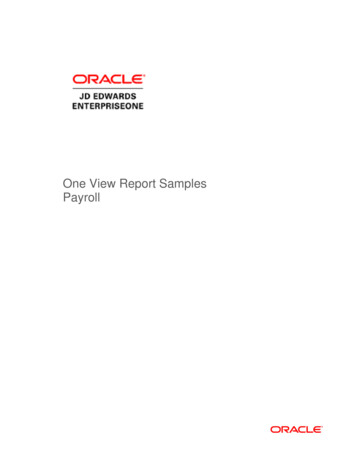
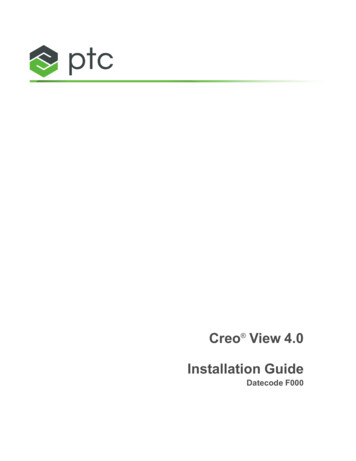


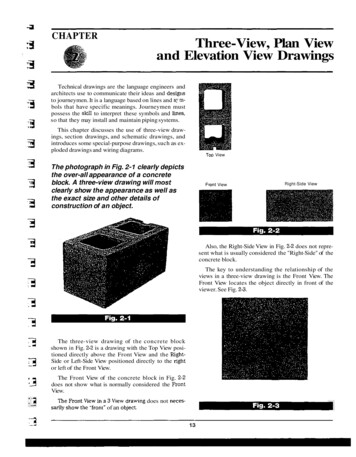
![Tier 1 Chiropractic Directory [as of April 2018]](/img/8/chiropractic-tier1.jpg)
